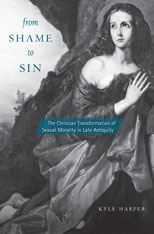"From Shame to Sin" by Kyle Harper. A Review
From Shame to
Sin: The Christian Transformation of
Sexual Morality in Late Antiquity
Kyle Harper
Harvard University Press
79 Garden Street
Cambridge, MA 02138
http://www.hup.harvard.edu/
ISBN 9780674072770; $42.00; June 2013
Assessing Antiquity: 5 of 5 Stars
Foucault,
Langlands, Williams, Verstraete and Provencal, along with an army of others,
have spilt gallons of ink to chronicle and choreograph the tricky and intricate
sexual mores of ancient Rome into the Christian era. Kyle Harper, Professor of Classics and Letters at
the University of Oklahoma and Executive Director of the Institute for the
American Constitutional Heritage, has added his voice to the discordant chorus in
his 316 page hardback, “From Shame to
Sin: The Christian Transformation of Sexual Morality in Late Antiquity.”
It is a work written for both the lettered and the thoughtful learner alike.
The author is clinical in his approach, analytical in his reading, and fairly impartial
in his objective.
“From
Shame to Sin” seeks to track the change in Roman sexuality over a roughly 600
year period as Roman society met, and became absorbed into, Christianity.
Harper does this by “exploring the late classical world out of which
Christianity emerged and following the story of the religion’s expansion down
to the age of the emperor Justinian” (preface). Since the author is a
classicist, it is no surprise that he accomplishes his task by following
romantic novels of the high imperial roman society to the late antiquity of
Christian Hagiographa. It provides not only an interesting excursion into the
romantic genre of the period, but also a contextual glance into the rules of
virtue and shame prevalent at the time. As the author observes, “The Christian transformation
of sex can be retraced in the history of literature, which mirrors quite sensitively
the passage from a public sexual ideology organized around the imperatives of
social reproduction to a mentality founded in ecclesiastical norms. In short,
the history of literature recapitulates the passage from shame to sin” (16). He
follows this transition through the second century work of Achilles Tatius’s Leucippe and Clitophon to the seventh
century composition of John Moschus’s The
Spiritual Meadow.
Harper
takes the reader by the hand and weaves them across the erotic ethics of Rome,
showing how the surplus of slave bodies provided a venue for plentiful outlets
to gratify the male libido. The author also chronicles the placement of
homoeroticism, whether pederasty, consenting adults, prostitutes and kinaidos, etc., that was widely
permitted for the freeman to engage in with both slaves and non-slaves; and how
same-sex marriage, which was not unknown, “had no legal standing or consequence
in public law” (36). He similarly recounts how the moral code for honorable
women was pudicitia (modesty), to
possess sexual honor. In the end, the author’s recitation shows how “the
symphony of sexual values, in all its various movements and complex harmonies,
was set to the rhythms of the material world: early marriages for women, jealous
guarding of honorable female sexuality, an expansive slave system, late
marriage for men, and basically relaxed attitudes toward male sexual potential,
so long as it was consonant with masculine protocols and social hierarchies”
(78).
“From
Shame to Sin” then tackles some New Testament passages as well as the writings
of Clement, and Tertullian, that address sexual behaviors showing how “the
novelty of Christian language mirrored the transformative logic of a
distinctive sexual morality” (98). Though several aspects of Christian sexual
morality are addressed, the author capitalizes on homoeroticism, showing how
from “Paul onward, Christian sexual ideology collapsed all forms of same-sex
contact, whether pederastic or companionate, into one category” (99), and that
category was porneia. Fornication
went from “being a cipher for sexual sin in general to a sign of all sex beyond
the marriage bed, and it came to mark the great divide between Christians and
the world. Same-sex love, regardless of age, status, or role, was forbidden without
qualification and without remorse” (85). Harper next maps out the direction this
new moral code took as Christianity became predominant in late Roman antiquity,
with the rigorous laws on the one hand, and the rigid asceticism on the other; “The
reign of Justinian marks a terminal point where sin and salvation, rather than
shame and reputation, have come to form the dominant axis of public regulation”
(158).
Since
one “proof of moral freedom was the ability of individuals to change” (127),
Harper spends much of the final portions of “From Shame to Sin” presenting one
area of change that became prominent in the literary works of late Rome. Novelists
and story-tellers maintained the format of the earlier romances, but changed
the tension-resolving conclusion from legitimate, honorable marriage to absorption
of the “gospel of virginity” (212). Another direction taken up by the
storywriters was the recounting and glamorizing of penitent prostitutes. “The
impresarios of the Christian imagination realized that in the figure of the
penitent prostitute they had not only the raw material for a Christian allegory
but a plot that could express the brave new world of sexual morality. The lives
of the penitent prostitutes were worked into antiromances, inverting the rich
fictional tradition to express an entirely new logic of sexual morality, a new
relationship between the sexual self and society” (222).
“From
Shame to Sin” is a scholarly read, looking through the lens of literature, to
see the social and sexual conversion of latter Rome. It’s richly informative, rigorous,
and reasoned. This would not only make an ideal addition to a University and
Seminary library, but it would be a worthy supplement to a pastors’ book
collection. Harper does a masterful job unpacking the social and sexual mores
of the Roman world at the time of the writing of the New Testament, which deepens
our understanding both the pressures warned against and the resistances prescribed
in the Christian Scriptures. I highly recommend the book.




Comments